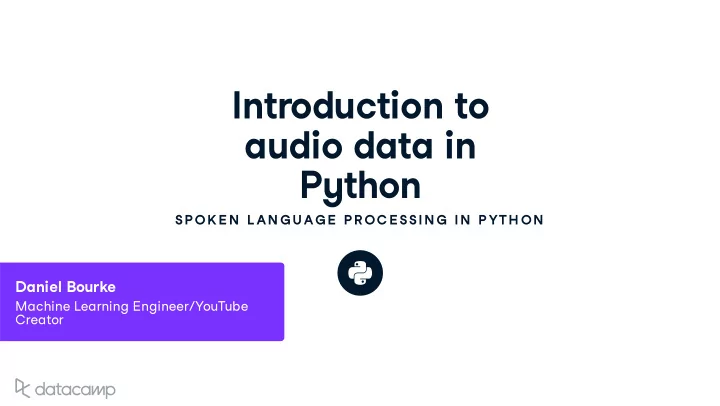

Introd u ction to a u dio data in P y thon SP OK E N L AN G U AG E P R OC E SSIN G IN P YTH ON Daniel Bo u rke Machine Learning Engineer / Yo u T u be Creator
Dealing w ith a u dio files in P y thon Di � erent kinds all of a u dio � les mp 3 w a v m 4 a � ac Digital so u nds meas u red in freq u enc y ( kH z) 1 kH z = 1000 pieces of information per second SPOKEN LANGUAGE PROCESSING IN PYTHON
Freq u enc y e x amples Streaming songs ha v e a freq u enc y of 32 kH z A u diobooks and spoken lang u age are bet w een 8 and 16 kH z We can ' t see a u dio � les so w e ha v e to transform them � rst import wave SPOKEN LANGUAGE PROCESSING IN PYTHON
Opening an a u dio file in P y thon A u dio � le sa v ed as good-morning.wav # Import audio file as wave object good_morning = wave.open("good-morning.wav", "r") # Convert wave object to bytes good_morning_soundwave = good_morning.readframes(-1) # View the wav file in byte form good_morning_soundwave b'\xfd\xff\xfb\xff\xf8\xff\xf8\xff\xf7\... SPOKEN LANGUAGE PROCESSING IN PYTHON
Working w ith a u dio is different Ha v e to con v ert the a u dio to something u sef u l Small sample of a u dio = large amo u nt of information SPOKEN LANGUAGE PROCESSING IN PYTHON
Let ' s practice ! SP OK E N L AN G U AG E P R OC E SSIN G IN P YTH ON
Con v erting so u nd w a v e b y tes to integers SP OK E N L AN G U AG E P R OC E SSIN G IN P YTH ON Daniel Bo u rke Machine Learning Engineer / Yo u T u be Creator
Con v erting b y tes to integers Can ' t u se b y tes Con v ert b y tes to integers u sing n u mp y import numpy as np # Convert soundwave_gm from bytes to integers signal_gm = np.frombuffer(soundwave_gm, dtype='int16') # Show the first 10 items signal_gm[:10] array([ -3, -5, -8, -8, -9, -13, -8, -10, -9, -11], dtype=int16) SPOKEN LANGUAGE PROCESSING IN PYTHON
Finding the frame rate Freq u enc y ( H z) = length of w a v e object arra y/ d u ration of a u dio � le ( seconds ) # Get the frame rate framerate_gm = good_morning.getframerate() # Show the frame rate framerate_gm 48,000 D u ration of a u dio � le ( seconds ) = length of w a v e object arra y/ freq u enc y ( H z) SPOKEN LANGUAGE PROCESSING IN PYTHON
Finding so u nd w a v e timestamps # Return evenly spaced values between start and stop np.linspace(start=1, stop=10, num=10) array([ 1., 2., 3., 4., 5., 6., 7., 8., 9., 10.]) # Get the timestamps of the good morning sound wave time_gm = np.linspace(start=0, stop=len(soundwave_gm)/framerate_gm, num=len(soundwave_gm)) SPOKEN LANGUAGE PROCESSING IN PYTHON
Finding so u nd w a v e timestamps # View first 10 time stamps of good morning sound wave time_gm[:10] array([0.00000000e+00, 2.08334167e-05, 4.16668333e-05, 6.25002500e-05, 8.33336667e-05, 1.04167083e-04, 1.25000500e-04, 1.45833917e-04, 1.66667333e-04, 1.87500750e-04]) SPOKEN LANGUAGE PROCESSING IN PYTHON
Let ' s practice ! SP OK E N L AN G U AG E P R OC E SSIN G IN P YTH ON
Vis u ali z ing so u nd w a v es SP OK E N L AN G U AG E P R OC E SSIN G IN P YTH ON Daniel Bo u rke Machine Learning Engineer / Yo u T u be Creator
Adding another so u nd w a v e Ne w a u dio � le : good_afternoon.wav Both are 48 kH z Same data transformations to all a u dio � les SPOKEN LANGUAGE PROCESSING IN PYTHON
Setting u p a plot import matplotlib.pyplot as plt # Initialize figure and setup title plt.title("Good Afternoon vs. Good Morning") # x and y axis labels plt.xlabel("Time (seconds)") plt.ylabel("Amplitude") # Add good morning and good afternoon values plt.plot(time_ga, soundwave_ga, label ="Good Afternoon") plt.plot(time_gm, soundwave_gm, label="Good Morning", alpha=0.5) # Create a legend and show our plot plt.legend() plt.show() SPOKEN LANGUAGE PROCESSING IN PYTHON
SPOKEN LANGUAGE PROCESSING IN PYTHON
Time to v is u ali z e ! SP OK E N L AN G U AG E P R OC E SSIN G IN P YTH ON
Recommend
More recommend